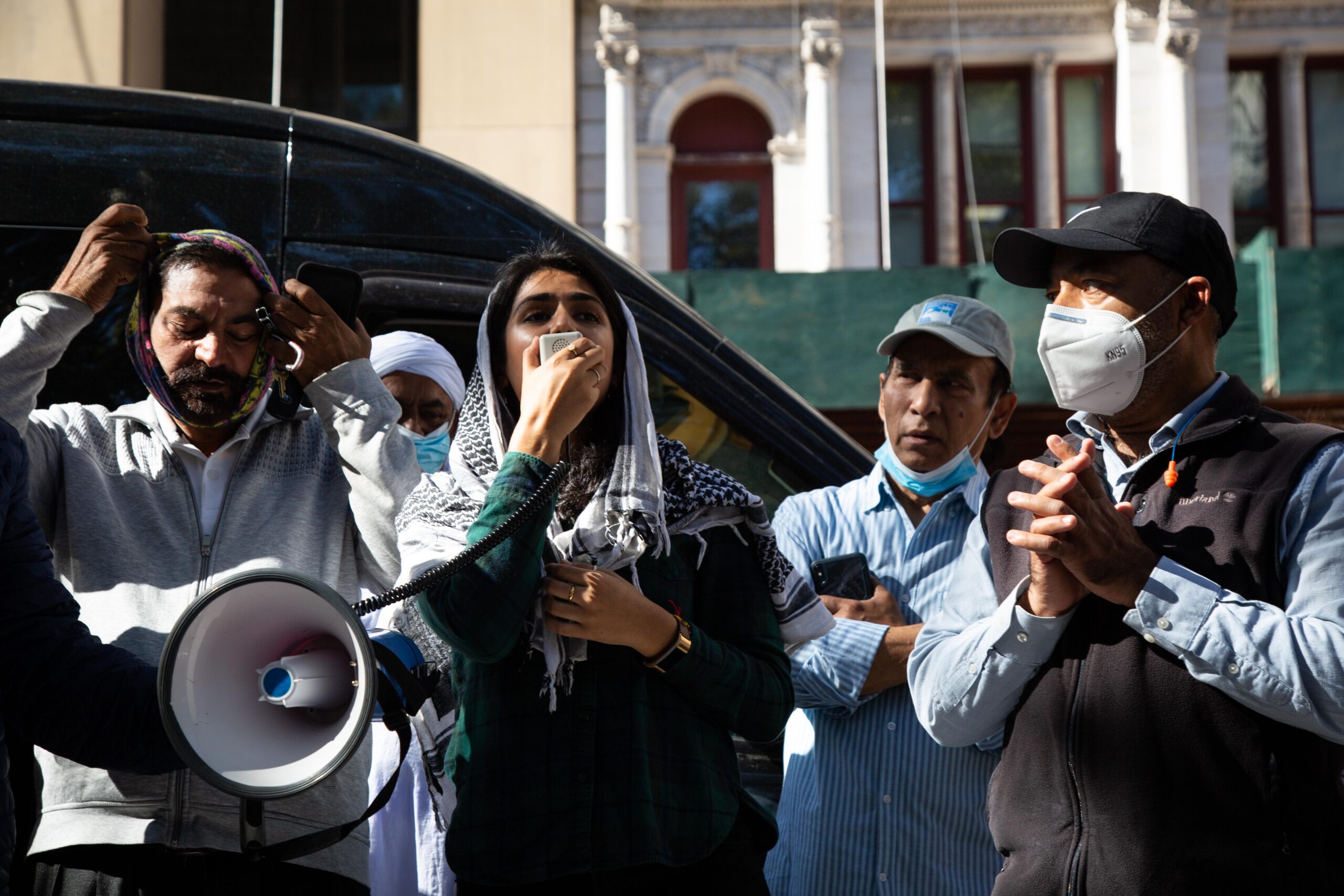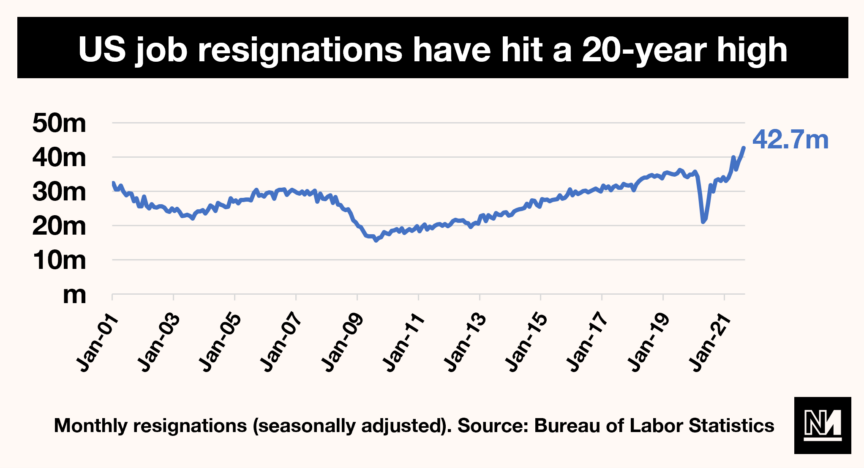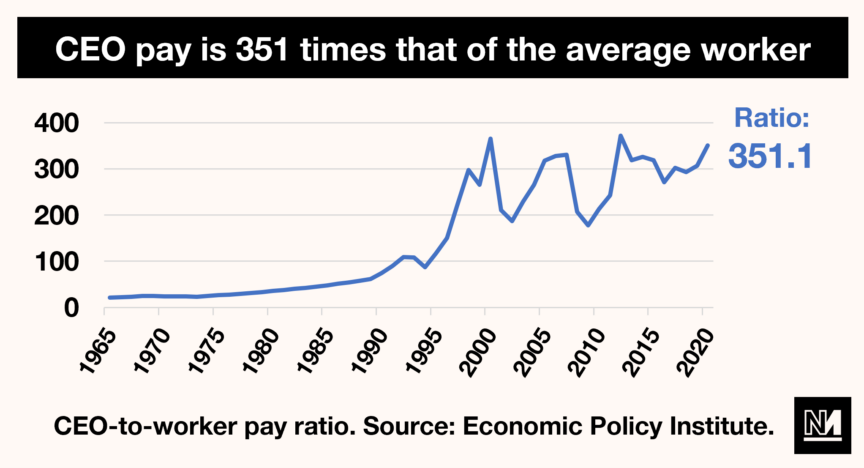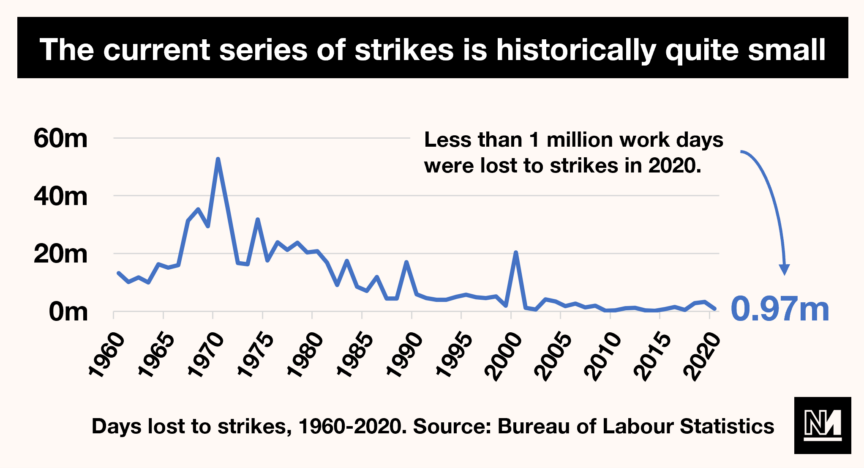Workplace Strikes in the US Are Surging – But Workers Have a Difficult Path to Victory
The current 'strike wave' pales in comparison to industrial actions just three years ago.
by Luis Feliz Leon and Maximillian Alvarez
2 November 2021

As the rich and comfortable stayed indoors and rode out the worst months of the pandemic on their Peloton bikes, workers around the US shifted into a different gear.
A series of strikes which all started this October – dubbed by some pundits as ‘Striketober’ – saw 10,000 farming equipment workers in Iowa, Illinois, Kansas, Colorado and Georgia walk out of their jobs, along with 1,400 cereal workers at Kellogg’s plants in Nebraska, Michigan, Tennessee and Pennsylvania, and 1,100 coal miners at Warrior Met Coal in Alabama and nurses in New York and Massachusetts.
Thousands more are waiting in the wings – from workers in academia, to healthcare workers at Kaiser Permanente in Oregon, California and Hawaii and Georgia , to film and television workers in the entertainment industry who averted a strike after threatening to walk off the job and reached a tentative agreement, which will now be voted on.
And that’s not all. New York City taxi drivers have idled their iconic yellow cars and camped outside City Hall for more than a month, holding a 24/7 protest vigil that escalated to a hunger strike on 19 October.
Drivers on day 12 of their hunger strike to #EndCabbieDebt are joined by 22 new strikers today.
We will not back down. Onward to victory!
Driver Power! Union Power! pic.twitter.com/ZpfNCXe03q
— NY Taxi Workers (@NYTWA) October 31, 2021
The hunger strike by members and supporters of the New York Taxi Workers Alliance took place before a fast-approaching quarterly budget modification deadline on 31 October. With a decision looming, if he so chooses, Mayor Bill de Blasio can add a loan guarantee to lower the monthly payments on the crushing debts that drivers have accrued (averaging half a million dollars per driver) as a result of predatory licensing schemes.
Whatever you want to call this marked uptick in worker militancy, one thing is clear: both generally, and on an individual level, workers in the US are more confident than they’ve been in a long time, and they are seizing the crisis in front of them and using it to their advantage.
Members of the vast ‘order-taking class‘ are deploying their newfound leverage to command better wages as employers struggle to fill vacancies in a tight labour market while the pandemic still rages across the nation. And it’s not just big, headline-grabbing strikes either; the increasing boldness and assertiveness of workers is manifesting in other important ways.
The ‘Great Resignation’.
“We are witnessing a unique opportunity for many workers who have been on the front lines of a global pandemic and recognize that employers are struggling to hire,” says Johnnie Kallas, project director of Cornell University’s Labor Action Tracker, an online database that documents labour actions and strikes no matter their size.
“We have documented six separate strikes by bus drivers—union and nonunion—since late September involving anywhere between 20 and 200 workers,” Kallas adds. “Nearly all these strikes include demands related to higher pay. Health and safety concerns have also been voiced by striking workers.”
Meanwhile, in what some pundits are dubbing the “Great Resignation” – others are calling it an “unofficial general strike” – between January and August some 30m US workers quit their jobs, a stunning collective rebuke – expressed on an individual level – to the common degradations of low-paying, demeaning jobs.

Stephanie Luce, a professor of labour studies at the City University of New York, notes that strikes extend beyond formal strike authorisations called by unions. “We may be seeing a lot more work stoppages that are not formal strikes called by unions, or formal strikes in smaller workplaces, and informal work actions,” she explains.
“We should consider the range of workplace actions workers engage in to protest their conditions of work, from formal strikes to work slowdowns, sick-outs and quitting. Workers have always employed a range of tactics that should be considered part of striking.”
And why not throw in the towel? The average worker is more productive than ever before but has seen their real wages stagnate for decades as the cost of living rises and the lion’s share of profits are siphoned off by those at the top. (The fact that the wealth of the one percent has exploded over the course of the pandemic has only made it clearer that we are all playing a rigged game.)
While workers struggle to keep their heads above water, CEO pay has soared to stratospheric heights, ballooning by 19% in 2020 – or $24.2m on average – according to an August study by the Economic Policy Institute.

Some have channelled their discontent into the throes of collective bargaining and bustled about the perimeter of picket lines. But while workers have, indeed, turned the heat on the bosses, the flame of worker militancy is not yet a blowtorch capable of setting off conflagrations of work stoppages across the country.
Since January 2021, there have been 198 strikes—53 of those strikes, involving approximately 28,200 workers, have occurred in October alone, according to the Labor Action Tracker. By contrast, the US Bureau of Labor Statistics, which only tracks work stoppages involving at least 1,000 workers, puts the figure at 12 since January 2021, based on data up to September 2021.
‘The term ‘strike wave’ gets thrown around too much.’
Here’s the sobering truth. The discontent fueling the current uptick in strikes and protests is incredibly important, but that uptick still pales in comparison to the 485,000 workers who went on strike in 2018 and the 425,000 in 2019 during a strike wave involving teachers in states from West Virginia to Arizona, as well as workers in auto plants and hotels.
1/Now that #Striketober has past, a 🧵 (and pix!) for historical context. These headlines are from 1945-46, the greatest US strike wave (by # of strikers) ever. It’s difficult now to comprehend how massive this expression of labor power was. Nearly 5 million workers were pic.twitter.com/GGtgLIKZgX
— Toni Gilpin (@ToniGilpin) November 1, 2021
Go even further back to 1971, when more than 5,000 work stoppages involving over 3m workers occurred, and the comparison to today’s strike numbers puts the reality of labour’s situation in even starker relief. Tens of thousands of workers fighting back in 2021 is significant, but there are roughly 14m union workers in the US alone, according to the Bureau of Labour Statistic’s 2021 annual report. Basically, it’s a big country – and we still have a long way to go.

“I think the term ‘strike wave’ gets thrown around too much because it depends on what you are comparing,” says Kallas. “We also know that changes in our economy have made striking much more difficult since the 1980s, making it important to contextualize these historical comparisons.”
The US left needs to identify and cultivate the passions among the US’ rank and file that have made this a special moment. But they also need to be clear-eyed about the deep challenges preventing this moment from becoming a movement.
For instance, while it’s become a routine journalistic genuflection to cite a September Gallup poll showing that more than 68% of Americans approve of unions, the amount of new workplace organizing efforts doesn’t match up to these shifting trends in public opinion.
At the very least, this should temper the US left’s feverish excitement about the potential of a new worker upsurge expanding to encompass millions of workers who can bring the bosses and our rigged economic system to their knees. They’re not there yet.
‘A failed strike can spread fear and hopelessness.’
Momentum building is crucial to movement building, and successful strikes are indeed contagious, emboldening workers elsewhere to take action in their own workplaces. But “a failed strike that ends with the strikers permanently replaced by scabs can spread fear and hopelessness across communities and industries,” writes Shaun Richman, the program director of the Harry Van Arsdale Jr. School of Labor Studies at SUNY Empire State College, in an article for In These Times.
Simply put, as much as new strikes and public excitement about worker struggles can help lift the labour movement off its back, failed strikes and fizzling public commitment to those same struggles can push the movement farther in the wrong direction.
Even if worker militancy is growing, workers have a deliberately narrowed path to navigate to victory, shaped by decades (even centuries) of anti-worker laws and anti-union culture. This is why, in the same piece, Richman makes the case for labour law reform, including the right to return to work after a strike (remember that fateful day in 1981 when scab-in-chief Ronald Regan fired over ten thousand air traffic controllers).
It’s also why many workers, labour leaders, and labour advocates have pushed for the passage of the Protect the Right to Organize Act – doing so, they argue, would open up pathways for workers to take today’s militancy and turn it into forms of worker organisation that have real teeth and muscles.
Our highest national priority through May Day is to pass the Protect the Right to Organize (PRO) Act, which would strengthen unions, the power of the working class to organize on the job, and our collective capacity to win a better world. #PassTheProAct pic.twitter.com/zvVXwH1FHa
— DSA 🌹 (@DemSocialists) March 26, 2021
If such changes to US labour law happened overnight, for example, it would have huge implications for miners in Alabama, who are going on eight months on strike and have seen scabs replace some workers (and hit picketers with their cars). Likewise, nurses in Massachusetts are approaching eight months on strike with their Texas-based employer Tenet Healthcare refusing to rehire striking workers while raking in $448m in profit in the third quarter.
“Leverage to win is obviously different in different industries and companies,” says Peter Olney, a former organising director of the International Longshore and Warehouse Union, pointing to the St. Vincent nurses and a national day of action he’s coordinating with the Democratic Socialists of America.
“Tenet has over 450 facilities and just brought in $2.4bn during Covid-19 and they are gushing with cash. They are making a political statement to unions that dare to challenge them. The path to settlement would be labour solidarity, but only 30 facilities are unionised nationwide and SEIU has a national ‘organising’ agreement with Tenet that forbids solidarity.”
‘Employers have far more rights than workers.’
While Olney welcomes the new militant attitude and workers’ desire for better jobs, he sounds a sober note about how that desire alone “cannot overcome pre-existing realities of union weakness and lethargy. Organising the massive un-organised private sector remains key”.
Luce agrees. “As much talk as we hear about workers gaining power in a tight labour market, these long strikes show the tremendous power imbalance that still remains between the average employer and the average worker,” she explains. “Employers have far more rights, resources, lawyers and political power than workers, which means that despite their cries of helplessness, the average employer will be able to outlast the average union on a picket line.”
Since April, two dozen workers at the United Metro Energy Corporation fuel terminal in Brooklyn, New York, have been out on strike after more than two years of negotiations broke down between Teamsters Local 553 and billionaire John Catsimatidis. Six months into that strike, eight workers have received permanent replacement letters. The Teamsters had already filed a complaint with the National Labor Relations Board for the company’s alleged targeting of union activists, and filed new charges as the investigation unfolded.
The workers of Teamsters Local 553 here in Greenpoint are on strike to demand the pay and benefits that they deserve.
Come out to the United Metro Energy site on Kingsland Ave to support them on the picket line! https://t.co/NjWURQHGPD
— Julia Salazar (@JuliaCarmel__) May 8, 2021
The original two dozen workers on strike have dwindled to 14 today, as many took jobs elsewhere when faced with permanent replacement letters, according to striking worker Ivan Areizaga, 56, a terminal operator who has been working at United Metro Energy Corporation for nearly six years.
“I dedicated myself to the company. I’ve been working from 10pm to 7am. They didn’t even have consideration that I have a family. I want to have a weekend with my kids,” he says. “The only time I took off was when my mother passed. Three days after, I came back to work, never missed a day, and did everything I was asked for.”
Beyond the long hours, Areizaga also discovered that he was earning $27 an hour when the industry standard for the same job is $37. A father of three, he began thinking about retirement and a pension, which led to him forming a union with his coworkers, all leaping at the prospect of financial stability.
“I’m 56 years old. How many years do I have to work in order for me to make a decent living and provide for my family?” he asks.
‘We’re not giving up.’
Catsimatidis, however, disagrees, saying in a statement to the local newspaper, The City, “As much as the union has the right to strike, we have a right, under federal labour law, to permanently replace employees to enable us to service our customers.” In this, he made it clear that the dictatorship of employers is largely a legal offensive.
Shortly after going on strike, Areizaga said the company cut his health benefits. He recounts the experience of his son, who has diabetes, calling from college in North Carolina, panicked because he couldn’t access his medication. “Dad, what’s going on,” his son said. “I can’t get my medication.”
“What we’re asking for, he’s got in his back pocket,” Areizaga said of billionaire Catsimatidis. “We were there through the pandemic when everybody was home; we were there providing for New York.”
Areizaga and his co-workers supply New York with heating oil, diesel and gasoline, which keeps the city’s schools, hospitals and the subway warm – they are also responsible for fueling local gas stations. They are nothing if not essential for the city and its residents. And yet, existing labour law makes it much easier than it should be for bosses to dissociate the work from the worker, allowing them to ignore the needs and concerns of employees like Areizaga, and ultimately replace them.
Catsimatidis did not respond to a request for comment.
“We’re not giving up. We have lost a lot already,” vows Areizaga.
More than just a hashtag?
If the US left wants Striketober to be more than just a short, bright moment in time, they cannot forget about workers like Areizaga (or the miners at Warrior Met Coal, or the nurses at St. Vincent Hospital).
They must do everything they can to help them win their struggles, ensuring they have a concerted strategy for addressing or removing the systemic barriers that make winning so hard.
While Striketober could just be a viral hashtag, what has happened this October signals a growing worker militancy in the US. The left must be ready to undergo its greatest challenge yet: rebuilding class organisations on an even greater scale in order to achieve a lasting rebalance of power in the struggle of the many against the rapacious few.
This article was first published on The Real News Network. It has been edited.
Luis Feliz Leon is a staff writer and organizer with Labor Notes.
Maximillian Alvarez is editor-in-chief of The Real News Network and host of Working People, a podcast about the lives, jobs, dreams and struggles of the working class today.


